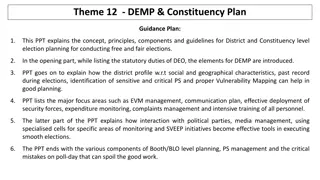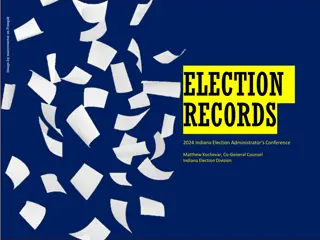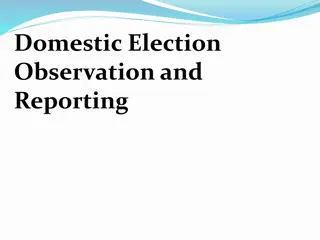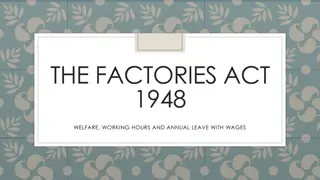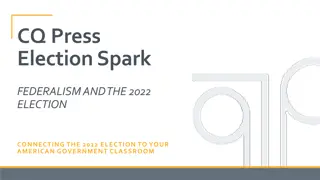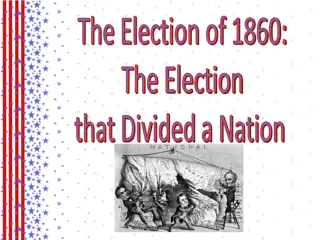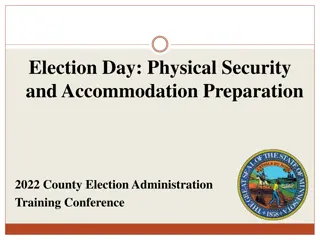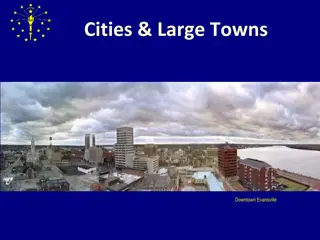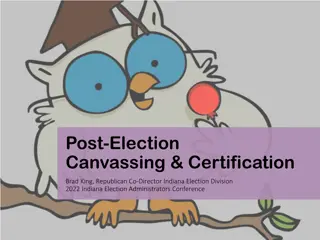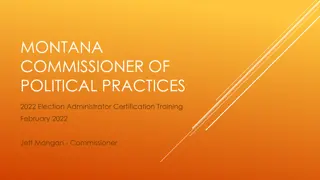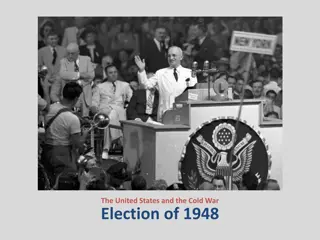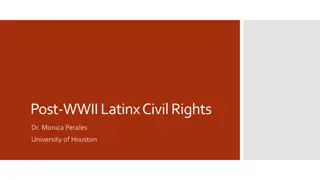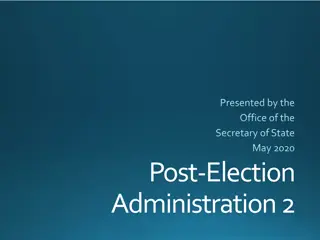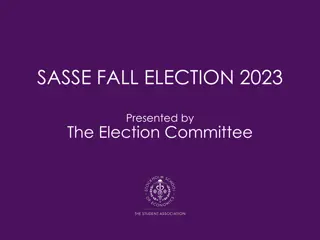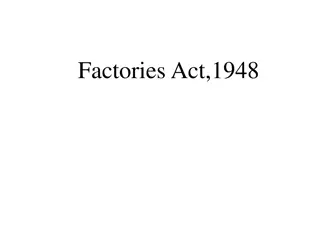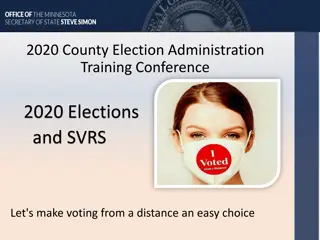Post-WWII America: Progress, Politics, and the Election of 1948
Lakewood, California's post-WWII boom symbolized the era's prosperity and status symbol of homeownership. Truman's Fair Deal faced Republican opposition, leading to postwar political shifts, including the 22nd Amendment and Taft-Hartley Act. The Election of 1948 saw Truman navigating Democratic factions and going against Dewey, showcasing the dynamic political landscape of the time.
Download Presentation

Please find below an Image/Link to download the presentation.
The content on the website is provided AS IS for your information and personal use only. It may not be sold, licensed, or shared on other websites without obtaining consent from the author. Download presentation by click this link. If you encounter any issues during the download, it is possible that the publisher has removed the file from their server.
E N D
Presentation Transcript
PEACE, PROSPERITY, PROGRESS
LAKEWOOD, CALIFORNIA Lakewood, CA was a farm town In 1950 the community boomed building 50 homes a day The Depression and WWII slowed the rate of home construction When the war ended millions of soldiers came home ready to start families The influx of new families led to the housing boom around America Owning a house became a status symbol of affluence and prosperity in the booming 1950 s
POSTWAR POLITICS Truman proposed his Fair Deal after WWII Increase minimum wage, aid to agriculture, and education funding Enacted a national health insurance program Republicans in Congress opposed this deal Truman was given the task of adjusting the post-war economy Faced inflation and unemployment from cancelation of defense contracts Republicans gained control of both the House and Senate for the first time since the 1920 s
Republicans pushed for the 22ndAmendment 22ndAmendment: Two term limit for the president Did not want to see another term like FDR where the Democratic Party dominated the executive branch for 4 terms Amendment had overwhelming support and passed Taft-HartleyAct: enacted many limitations on labor unions Outlawed closed shops workplace where employers only higher members of particular unions Outlawed sympathy strikes where people would go on strike to show support for other unions on strike Allowed president to impose an 80 day cooling off period for unions on strike
ELECTION OF 1948 Democrats broke into 3 factions Democrats were losing faith in Truman Henry Wallace former U.S. VP led one faction focusing on friendlier policies towards the USSR to prevent WWIII States Rights Democratic Party: led by Strom Thurmond from S.C. and focused on segregation of the races and states rights Members were known as Dixiecrats Republicans nominated Thomas E. Dewey Favored to win the election
Truman decided he would still put up a fight for the presidency although he didn t really like being president He launched a whistle stop tour Stopping in small towns to speak directly to voters On the day of election everyone predicted a Dewey landslide victory Truman won in one of the biggest electoral upsets in history Over Truman s next term her continued to re-introduce his Fair Deal policies with little success against a Republican Congress
ELECTION OF 1952 Democrats elect Adlai Stevenson Republicans nominated war hero Dwight D. Eisenhower Eisenhower was head of NATO after winning WWII Eisenhower s nickname was Ike Slogan of the campaign= I Like Ike Ike chose Richard Nixon has his VP He was a popular anti-communist senator Ike won a landslide victory against Stevenson in 1952 and again against him in 1956
IKES PRESIDENCY He introduced program called modern Republicanism Conservative when it comes to money Liberal when it comes to human beings Resisted the call to eliminate New Deal legislation Actually expanded social security to ensure its existence into the future Led the U.S. through the Arms Race by spending massive quantities on arms and defense
ECONOMIC GROWTH: The cars were jamming up the lot. Customers weren t demanding it, but our intuition told us they would like speed. Dick McDonald McDonalds became the first fast food company in the U.S. setting their restaurant like an assembly line During WWII American s saved billions of dollars that they could now spend Real Income: amount of goods and services income will buy regardless of inflation By the mid 50 s real income was double that of the 1920 s
Spent this new money in new ways Shopping Centers and mini-malls became the primary shopping destinations Advertising campaigns were used just like in the 1920 s $8 Billion alone in 1955 spent on ads Charge cards were given from large stores to allow people to buy on credit Sears had over 10 million charge accounts in 1960 In 1958 American Express launched America s first all charge credit card
Planned Obsolescence: businesses planned on making something bought today out of date within a short time period Noticed people wanted something a little newer, better, and sooner than necessary General Motors grew to be the first corporation to earn over $1 Billion dollars The economy would begin to shift from goods to services by the end of the decade
Rise of Fast Food: Ray Kroc convinced the McDonald brothers to franchise their business Franchise: agreement to operate a business that carries a company s name and sells its products by someone else McDonalds began to spread all over the country selling more than 1 billion burgers by 1963 White Collar to Blue Collar: Blue-collar workers were factory workers, skilled tradesmen White-Collar workers were doctors, lawyers, engineers Both groups prospered in the 50 s As blue collar workers moved up they began to shift into the white- collar lifestyle
FAMILY OF THE 50S Marriage rates and birthrates dropped during the depression and WWII 2.3 million new marriages in post-war 1946 Avg. marriage age was 22 for men and 20 for women Started families right away which led to the baby boom Largest increase in birth rates America has ever seen 1957: 4.3 million births Baby related industries flourished as well as schools
Baby boomers grew up in traditional homes Dads worked, Mom s stayed home Family was a key part of life Dr. Benjamin Spock: wrote Common Sense Book of Baby and Child Care which advocated for stay at home moms Mass media reinforced this idea in magazines, movies, ads and now TV Show Leave it to Beaver reinforced stay at home moms with June Cleaver s character staying home and cooking/cleaning Emphasis on marriage and stay at home moms led to many women not going to college or entering work force
POPULATION SHIFTS: Home building industry was the hardest hit by the Depression WWII vets were ready to use GI Bill money to start buying homes again Levittown: first planned community in the U.S. One in Long Island, one in PA, and one in NJ The Levitt brothers built small, boxy, identical homes that had 2 bedrooms and 1 bathroom Houses were built through an almost assembly line like process Built nearly 36 houses a day for under $8,000 # of American s living in the suburbs increased by nearly 50% by 1950 Mostly white middle class families
Americans also began moving south towards the Sunbelt Belt of warm weather states from Florida to California Businesses moved south for lower labor costs after WWII People and industries moved with them New tourist spots like beach line communities and Disneyland opened up From 1950-1960 California s population grew 50% Building dams along rivers in the SW of America made this movement possible Air conditioners also made the move to the Sunbelt attractive and cool
IMPORTANCE OF THE AUTOMOBILE Suburban life required heavy dependence on the automobile Not much public transportation available and needed cars to get to the city/work Stay at home mom s needed cars to get to the super-market or shops Suburban families now need two cars Cars also became a status-symbol Families became obsessed with keeping up or one-upping their neighbors Throughout the 50 s car sales were above 7 million a year Over 67 million cars on the road by 1958 with over 12 million families having 2 or more
More and better roads began to be built in response to the rise of cars The gov. began funding massive road work projects In 1956 Congress passed a program to create an interstate highway system Connect major cities throughout the country by super-highways Eisenhower supported this program based on seeing how it was used on Germany s autobahns Saw it important to the U.S. defense in the Cold War Interstate highways are divided with at least 2 lanes on each side accessible by on/off ramps Travel was faster, safer, and shorter Led to roadside businesses sprouting as well as motel/hotel chains
TECHNOLOGICAL ADVANCEMENTS: New medicine led to an increase in life expectancy Vaccines like the new Polio vaccination were created Surgical procedures advanced as well First open heart surgery and kidney transplant Antibiotics helped prevent diseases once viewed as killers from causing much harm Tuberculosis, pneumonia and other diseases were now manageable By 1960 the avg. life expectancy was nearly 70 years
Harnessing Nuclear Energy: 1957 first nuclear power plant opened up in Shippingport, PA Radioactivity began being used in medicine as well X-rays and radioactive iodine began being used for body scans and cancer treatment Computers: University of Penn created one of the earliest computers in 1946 called ENIAC It was the size of two Levittown homes U. Penn created the first commercial computer in 1951 called UNIVAC UNIVAC accurately predicted election of Eisenhower in 45 seconds after polls closed Computers shrank in size and grew in use in the workplace



